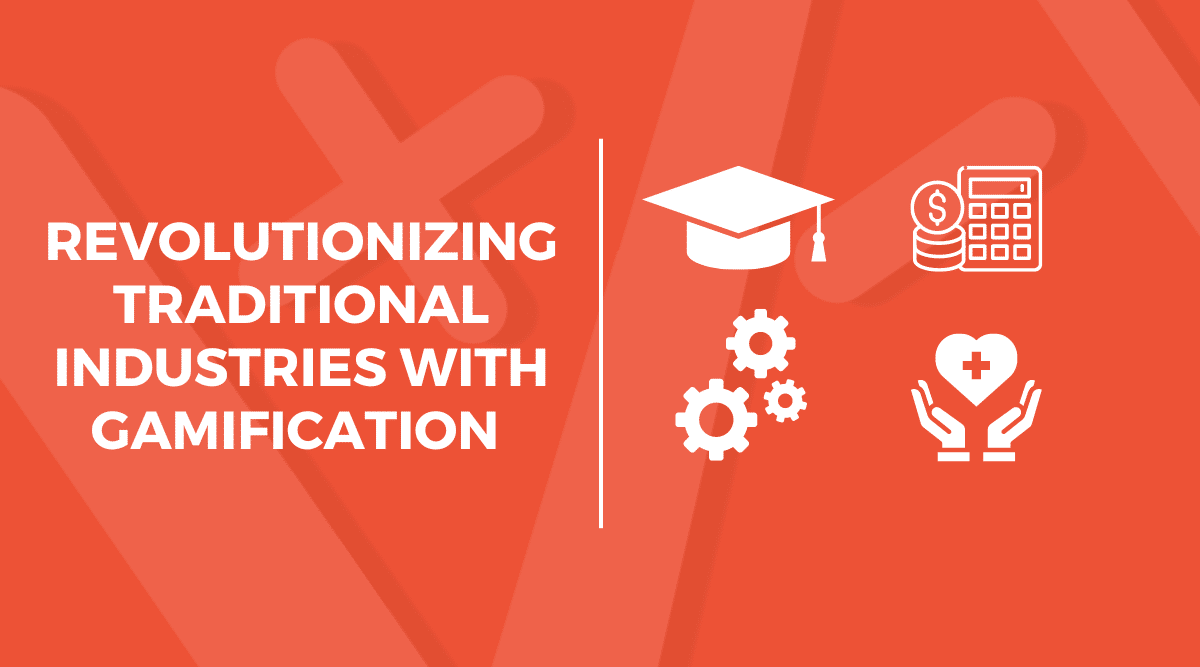Gamification in Traditional Industries: A New Era of Innovation
In the evolving landscape of business innovation, a transformative player has emerged, reshaping the dynamics of traditional industries. This transformative force is gamification – the strategic application of game-design elements in non-gaming contexts. This concept transcends mere point-scoring and leaderboards; it represents a holistic approach to enhancing engagement, efficiency, and employee motivation. As conventional sectors navigate the complexities of modernization, gamification stands out as a compelling tool to revive old business models. In this blog we will explore the profound impact of gamification on industries ranging from manufacturing to healthcare, offering a nuanced perspective on how established practices are being redefined.
The Essence of Gamification in Business
At its core, gamification in the business context is about leveraging the psychology that drives human engagement in game playing and applying these principles to non-game activities, particularly in the workplace. It’s a strategic approach that seeks to enhance not only productivity but also employee satisfaction and loyalty. In an era where employee engagement is a significant determinant of organizational success, gamification offers a unique and innovative solution. By integrating elements such as point scoring, competition, and rules of play, businesses can transform mundane tasks into engaging and motivating experiences. This approach capitalizes on the inherent human desire for achievement, recognition, and reward, effectively turning work into a more fulfilling and enjoyable endeavor.
The relevance of gamification today cannot be understated. In a world where traditional business models are continually challenged by technological advancements and shifting market dynamics, maintaining employee engagement and motivation is more crucial than ever. Gamification addresses this need by introducing an element of play and competition, which is known to enhance learning, improve problem-solving skills, and foster team collaboration. Moreover, it aligns well with the digitalization of the workplace, making it a timely and pertinent strategy in the modern business environment.
Gamification in Action: Real-World Applications
The application of gamification transcends industry boundaries, finding its place in sectors as diverse as healthcare, education, finance, and manufacturing. In healthcare, for instance, gamification strategies are being used to encourage healthy behaviors in patients and to train medical staff in a more engaging manner. Educational institutions are leveraging game mechanics to enhance student engagement and learning outcomes. In the financial sector, companies are utilizing gamified platforms to promote financial literacy and customer engagement, making complex financial concepts more accessible and engaging.
Manufacturing industries, traditionally viewed as rigid and process-driven, are also embracing gamification. By gamifying safety training and compliance processes, they are enhancing employee participation and retention of critical safety information. Sales departments across various industries are using leaderboards and performance tracking games to motivate their teams, driving sales growth and employee competitiveness in a healthy and constructive way.
These practical applications underscore the versatility and efficacy of gamification. It’s not merely about making work fun; it’s about utilizing the principles of game design to achieve specific business objectives, whether it’s improving learning and development, enhancing customer engagement, or boosting employee performance.
The Tangible Benefits of Workplace Gamification
The adoption of gamification in traditional industries is not just a trend; it’s a strategy yielding tangible benefits. One of the most significant advantages is enhanced employee engagement. Gamification transforms routine tasks into interactive experiences, fostering a sense of achievement and motivation among employees. This increase in engagement often translates into higher productivity levels, as employees become more invested in their work and the outcomes they can achieve.
Another key benefit is the improvement in learning and development. Gamified training sessions have been shown to increase knowledge retention and make the learning process more enjoyable and impactful. This is particularly crucial in industries where ongoing training is essential for maintaining high standards of practice and compliance.
Furthermore, gamification aids in fostering a positive workplace culture. It encourages healthy competition, collaboration, and social interaction among employees, contributing to a more dynamic and cohesive work environment. This can be particularly valuable in traditional industries where work processes might otherwise be seen as monotonous or uninspiring.
Additionally, gamification provides valuable data insights. Through gamified systems, businesses can gather data on employee performance and engagement, offering insights for continuous improvement and personalization of workplace strategies.
Navigating the Challenges of Implementing Gamification
While the benefits of gamification are clear, its implementation is not without challenges. One of the primary concerns is ensuring that the gamification strategy aligns well with the company’s goals and culture. It’s crucial that these initiatives do not feel forced or superficial, as this can lead to employee disengagement, the very issue gamification aims to combat.
Another consideration is the balance between competition and collaboration. While competition can be a strong motivator, it’s important to ensure it doesn’t lead to unhealthy rivalry or stress. Similarly, the rewards system must be carefully designed to ensure fairness and inclusivity, preventing any perception of bias or favoritism.
There’s also the challenge of maintaining the relevance and appeal of the gamified system over time. What starts as an engaging and novel approach can lose its luster if not regularly updated or if it fails to evolve with the changing dynamics of the workplace.
Furthermore, businesses must consider the investment in terms of resources and time. Developing and implementing a gamification strategy requires careful planning, design, and ongoing management to ensure its effectiveness and alignment with business objectives.
The Future of Gamification in the Business World
The future of gamification in business looks promising, as it continues to evolve and adapt to the changing needs of the workforce and advancements in technology. We are likely to see more sophisticated and integrated gamification systems, leveraging emerging technologies like artificial intelligence (AI) and machine learning to create more personalized and immersive experiences.
There’s also a growing trend towards using gamification for social and environmental causes within organizations. Companies are increasingly recognizing the power of gamified strategies to promote sustainability, social responsibility, and community engagement among their employees.
Another exciting development is the potential integration of gamification with virtual and augmented reality (VR/AR) technologies. This could revolutionize training and development programs, offering highly immersive and interactive learning experiences that significantly enhance skill acquisition and employee engagement.
As industries continue to navigate digital transformation, gamification stands out as a key player in shaping the future of work. It offers a unique blend of motivation, engagement, and innovation, making it an invaluable tool for businesses looking to stay competitive and adaptable in an ever-evolving marketplace.
Implementing Gamification: Strategies for Success
For businesses considering gamification, the key to success lies in thoughtful implementation and alignment with organizational objectives. Here are some strategic steps to effectively integrate gamification into business processes:
- Define Clear Objectives: Start by identifying specific goals you want to achieve with gamification, whether it’s increasing sales, improving employee training, or enhancing customer engagement.
- Understand Your Audience: Tailor the gamification elements to fit the interests, motivations, and behaviors of your employees. This ensures higher engagement and relevance.
- Integrate with Business Processes: Ensure that the gamification strategy is seamlessly integrated into existing business processes and workflows. It should complement, not complicate, the current operations.
- Focus on Intrinsic Motivation: While extrinsic rewards like points and badges are important, focus on fostering intrinsic motivation by making tasks more meaningful and enjoyable.
- Use the Right Technology: Leverage the appropriate technology platforms to support your gamification strategy. This could range from simple mobile apps to complex enterprise software.
- Iterate and Evolve: Gamification strategies should not be static. Regularly collect feedback and be prepared to make adjustments to keep the system engaging and effective.
- Measure and Analyze: Implement metrics and analytics to measure the impact of gamification on business objectives. This data will guide continuous improvement and ROI analysis.
By following these steps, businesses can create a gamification strategy that not only entertains but also aligns with and supports their overarching goals.
Inspiring Examples: Gamification Success Stories
The impact of gamification is best understood through real-world examples where it has revolutionized traditional practices:
- Duolingo in Education: Duolingo, a language-learning platform, successfully gamified the learning process with its point-scoring system, in-app rewards, and interactive lessons, making language learning accessible and engaging for millions worldwide.
- Nike+ in Fitness: Nike+ gamified fitness by allowing users to track their progress, set goals, and compete with friends. This not only increased user engagement but also cemented Nike’s brand in the digital fitness community.
- M&M’s Eye-Spy Pretzel Campaign in Marketing: M&M’s used a simple gamified concept in their Eye-Spy Pretzel campaign, where users were challenged to find a pretzel hidden in a sea of M&M’s. This campaign went viral, significantly boosting brand engagement.
- Starbucks Rewards in Retail: Starbucks’ rewards program gamifies customer loyalty by offering points, levels, and rewards, encouraging repeat business and enhancing the customer experience.
- SAP’s Community Network in Enterprise Software: SAP used gamification to increase participation in its online community, rewarding members for helpful answers and contributions, leading to increased user engagement and knowledge sharing.
These examples demonstrate the broad applicability and effectiveness of gamification across various sectors, showcasing how traditional industries can innovate and engage audiences in new and exciting ways.
Gamification: A Game Changer in Business Innovation
The journey through the world of gamification in traditional industries underscores its role not just as a trend, but as a significant game changer in the landscape of business innovation. Gamification transcends traditional boundaries, injecting creativity, engagement, and a dynamic competitive edge into the fabric of conventional business practices. It has proven to be an effective tool for addressing some of the most pressing challenges in the workplace, from employee disengagement to the need for continuous skill development.
Looking forward, the potential of gamification in reshaping traditional industries is immense. As businesses continue to adapt to an increasingly digital and fast-paced world, the principles of game design offer a pathway to more engaging, efficient, and innovative practices. Whether it’s through enhancing customer engagement, improving employee performance, or fostering a culture of continuous learning and improvement, gamification holds the key to unlocking new levels of success in a variety of sectors.
In conclusion, as we embrace the future of work, gamification stands as a testament to transforming the way businesses operate and thrive. It’s not just about playing games; it’s about leveraging the principles of gaming to create more meaningful, engaging, and successful business environments.



